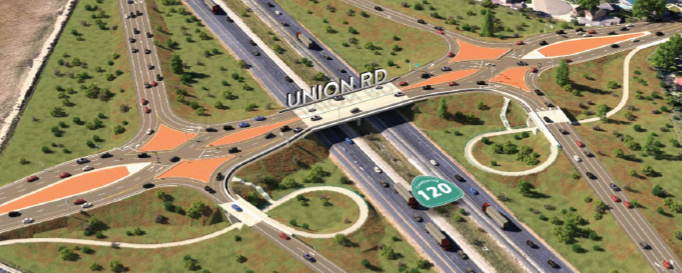Manteca could save up to $200,000 and have work done on the diverging diamond interchange at Union Road and the 120 Bypass four months ahead of schedule.
And, as an added bonus, work would be done before Black Friday to make sure critical holiday traffic to Bass Pro Shops that draws 97 percent plus of its customers from within a 100-mile radius and is one of the city’s biggest collectors of sales tax won’t be impeded by construction.
It also means auxiliary lanes on both sides of the 120 Bypass from Union Road to Main Street and Airport Way will be open in time for the holiday traffic crush to help reduce the potential for traffic slowdowns and accidents that happen with off-ramp traffic backs up onto freeway lanes.
All it requires is for all of the on and off ramps in both directions to be closed starting next month through late November. That would require those that are currently accessing or exiting the freeway at Union Road to use either Airport Way or Main Street instead for three months.
The option that would save $200,000 is one of three the City Council will be asked to decide between when they meet Tuesday at 7 p.m. during a remote Zoom meeting livestreamed on the city website and broadcast on Comcast Channel 97.
A second option would close all the ramps for only one month — September — and reduce the savings to $100,000.
The third option is to stay with the original plan to close the ramps for short periods of time. That would mean the project would not be completed until March 2021.
The first two options could greatly or actually eliminate the potential for claims from the contractor because of their inability to start the project as agreed to in the bid process. Teichert could not start the work for six months due to PG&E not relocating for transmission lines as the utility company originally promised.
Teichert worked with the city to find ways to save money through value engineering that led to the current ramp closes that knocked four months of work off the schedule by eliminating the need to have rotating closures, temporary routing through the ramps, and flaggers.
The options that will save either $200,000 or $100,000 will make up for the other two months PG&E pushed the project back. It does it through all the aforementioned reasons plus temporary lane markings and such won’t have to be placed and then removed on Union Road.
It cost almost $4 million to relocate the four poles on top of the $28.4 million interchange work. PG&E ended up covering half of the cost while the city was responsible for the other half. The San Joaquin Council of Governments agreed to cover 50 percent of the city’s share of the transmission pole relocation up to $1 million from Measure K sales tax receipts.
The interchange project is being funded from redevelopment bond money, Measure K sales tax, sand fees paid by growth.
Ironically who paid for the power pole relocation became an issue because the design of a diverging diamond interchange allowed the widening of the Union Road overcrossing to four lanes and putting subsequent ramp improvements in place without the need to buy additional right-of-way.
Since the actual construction of the Union Road interchange project is being funded 100 percent with local funds and involves no money from state or federal sources the state isn’t a part of right-of-way activities that includes sharing in the cost of the relocation. That had been a sticking point given at one point Caltrans contended PG&E should pick up 100 percent of the cost.
Even with the additional cost the city incurred due to PG&E, Manteca is still money ahead compared if they had gone with a partial or full cloverleaf. Besides both requiring more right of way the existing Union Road overcrossing would have had to be torn down.
In the end the new interchange will be in place for $10 million less than a conventional interchange.
It is also California’s first diverging diamond interchange. A second one is moving forward in Ceres along Highway 99.
Manteca anticipates using the same design when the city goes to widen overcrossings on interchanges at Main Street and Airport Way along the 120 Bypass.
With a diverging diamond interchange the flow across the freeway has lanes crossings to the opposite side of Union Road where the ramps are and then crossing back over at the ramps on the other side of the bridge.
Where the traffic crisscrosses they are traffic signals. On a traditional overpass turn movements on and off the freeway would also go through the traffic signals. That’s not the case with a diverging diamond interchange.
If Union Road was improved to a partial cloverleaf interchange as was originally envisioned there would be 24 conflict points for vehicles. The diverging diamond has 12.
Even more significant is the reduction in the potential for frequent T-Bone crashes that can result in extensive property damage and serious injury. There are 20 such conflicts on a traditional interchange and just two on a diverging diamond. Those two would be where the north and south lanes on Union Road crisscross.
Due to the interchange’s geometry the average speed is slowed from 40 mph to 25 mph.
To contact Dennis Wyatt, email dwyatt@mantecabulletin.com





